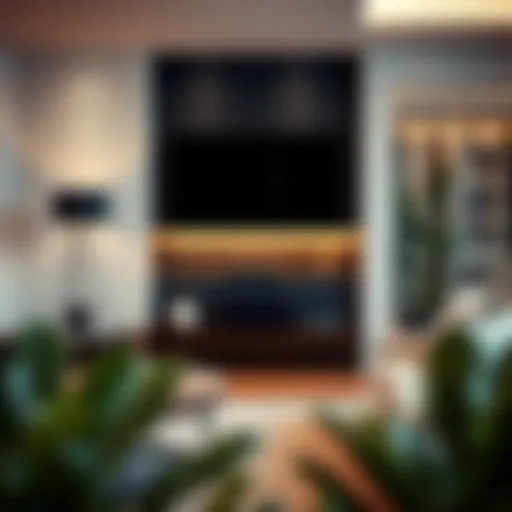Exploring 72 Bathroom Countertops: Functionality and Style
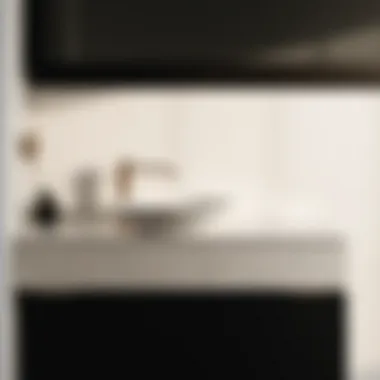
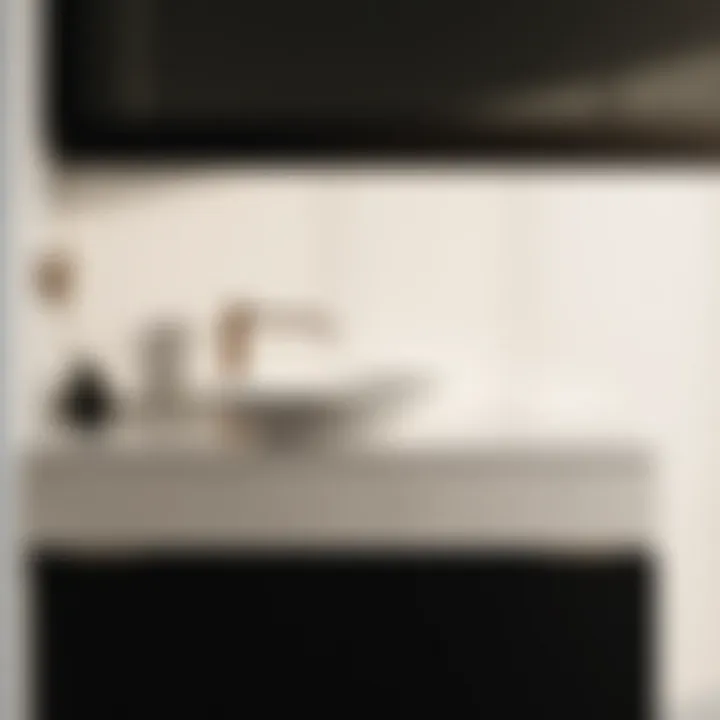
Intro
In the realm of bathroom design, countertops play an unsung role that is often overshadowed by other elements like fixtures and color schemes. Yet, they are pivotal in not just shaping the aesthetic of the space but also affecting its functionality. This article takes a deeper dive into the vast selection of 72 bathroom countertops, where each option brings its own set of characteristics to consider. From luxurious marble to durable quartz and from rustic reclaimed wood to sleek glass, the choices are nearly limitless.
Understanding the suitable countertop for your space goes beyond mere style; it requires recognizing how these surfaces can influence the overall feel and use of the bathroom. In this exploration, we’ll assess current trends, material variations, and practical considerations that every homeowner, designer, or decor enthusiast must weigh. From high-end finishes to budget-friendly alternatives, insights into choosing countertops can transform an ordinary bathroom into an extraordinary living space. Prepare to embark on a journey where functionality meets flair, affording your bathroom the distinct personality it deserves.
Intro to Bathroom Countertops
When it comes to designing a bathroom, choosing the right countertop can either make or break the space. The 72 bathroom countertop represents a standard size that many homeowners and designers gravitate towards due to its balance in functionality and style. But why should we even care about the specifics of selecting a countertop? Well, for starters, a well-chosen countertop sets the tone of the entire bathroom, reflecting personal taste and lifestyle.
It's paramount to realize that bathroom countertops not only serve as a workspace but also as a focal point. They are often the first feature that catches the eye, be it a stark white quartz or a rustic butcher block. Bathrooms are generally the smallest rooms in a home, but they hold massive potential, and the countertop plays a crucial role in maximizing that potential.
Benefits of a Bathroom Countertop
The versatility offered by a 72 bathroom countertop is noteworthy. The size is spacious enough to accommodate everyday needs while still fitting comfortably in most bathrooms. Here are several benefits of this countertop size:
- Ample Surface Area: More room for toiletries and decorative items.
- Design Flexibility: Can work in both contemporary and traditional settings.
- Increased Home Value: A well-designed bathroom is a significant selling point for potential buyers.
However, while the technical specifications matter, the emotional impact is just as significant. The right countertop can evoke a feeling of luxury, relaxation, or even whimsy, depending on the materials and colors selected. Understandably, the vast options can overwhelm, making the desired choice appear like finding a needle in a haystack.
However, if you dive deep into understanding the defining elements of your options, it becomes a more manageable task. Countertops can range from natural stones like granite to synthetic options like quartz or even reclaimed materials. Each choice brings with it not only a unique aesthetic but practical considerations such as durability and maintainability.
In summary, the 72 bathroom countertop merges beauty and function. It commands attention in any bathroom space, making it a critical aspect of design that deserves careful consideration. As we venture further into this article, we will explore various materials available, how they can fit different design themes, and the functional aspects that guarantee satisfaction for years to come.
"Choosing the right countertop is like selecting a perfectly crafted suit; it should fit well and express who you are—combined with practicality, of course."
Understanding the historical context of bathroom countertops can shed light on current trends and preferences. It also provides a fascinating glimpse into how their design and materials have evolved over time. Let's take a closer look.
Material Options for Bathroom Countertops
Material selection is a fundamental aspect when it comes to creating the perfect bathroom countertop. Not only does it significantly impact the overall look and feel of your space, but it also dictates functionality and performance. With a plethora of materials available, understanding the unique properties, benefits, and limitations of each option can help homeowners, designers, and DIY enthusiasts make informed choices.
The right material can harmonize with your bathroom’s décor, seamlessly blending aesthetics with durability and maintenance needs. Let’s delve into the different material categories and explore their merits thoroughly.
Natural Stone Surfaces
Natural stone countertops are renowned for their unique aesthetics and durability. They offer a timeless charm that can elevate any bathroom setting. Here’s a look at three popular types of natural stone:
Granite
Granite is amongst the most sought-after materials for bathroom countertops. Its key characteristic is that each slab is unique, showcasing a variety of colors and patterns, which adds immense visual interest. The durability of granite makes it resistant to scratches and heat, making it a solid choice for everyday use. Though it has a reputation for being a luxurious option, its longevity can justify the cost.
However, one must consider the need for regular sealing. Unlike some other materials, granite can be porous and may stain if not maintained properly. But when cared for, the natural beauty of granite can make it a beneficial addition to any bathroom.
Marble
Marble brings elegance and sophistication that is hard to surpass. Its primary feature is the distinctive veining that runs through each slab, creating a unique aesthetic appeal that can enhance both modern and traditional designs. Marble is often associated with luxury and, although it is softer than granite, it offers a unique allure in terms of design continuity and texture.
On the downside, marble is more prone to scratching and staining. It requires careful maintenance, with a preference for gentle cleaning solutions to avoid dulling its natural sheen. Ultimately, for those who prioritize beauty over low-maintenance needs, marble could be the ideal choice.
Soapstone
Soapstone is an often-overlooked gem in the natural stone category. It’s known for its softer feel and is less porous than granite, making it resistant to staining. The key characteristic of soapstone is its smooth texture, offering a pleasant tactile experience while maintaining a rustic charm due to its natural earth tones.
For those looking for a low-maintenance option, soapstone is quite forgiving, as it does not require sealing in the same way other stones do. The drawback, however, lies in its susceptibility to scratches and dents, making careful usage paramount.
Composite Materials
Composite materials blend natural and manufactured substances, creating styles that are often heavier on aesthetic flexibility and lower on upkeep.
Quartz
Quartz countertops are engineered rather than sourced directly from nature, allowing for an extensive variety of colors and patterns not typically found in natural stones. The durability of quartz is outstanding, providing resistance against scratching and staining, rendering it one of the most practical options for busy bathrooms.
A unique feature of quartz countertops is that they are non-porous, eliminating the need for sealing. The only downside is that direct exposure to excessive heat can cause damage, so using a mat or trivet is always wise.
Solid Surface
Solid surface materials, often made from acrylics and resins, provide seamless designs that are not only visually appealing but also easy to maintain. The key characteristic of solid surfaces is their ability to be molded into various shapes and sizes, making them incredibly versatile for different designs.
While scratches can occur, they can usually be sanded out, bringing the surface back to near-new condition. However, they are less resistant to heat when compared to natural stones, which may be a consideration for some homeowners.
Recycled Options
In an age where environmental consciousness is crucial, recycled materials such as glass or reclaimed stone offer an eco-friendly countertop alternative. The primary advantage is not only their unique appearance, often featuring striking coloration patterns, but also their contribution to sustainability. These surfaces can automatically add a story to the bathroom design, making them conversation starters.
The drawback, however, could be their relative susceptibility to chipping depending on the manufacturing process, which is something to take into account during selection.
Wood and Other Materials
Though less traditional, wood and various composite materials can introduce warmth and uniqueness to bathroom countertops.
Butcher Block


Butcher block can be an unexpected yet delightful choice for a bathroom countertop. The key feature of butcher block is its warm, inviting feel, which can soften harder bathroom elements. This material is surprisingly durable, especially if well taken care of, though regular oiling is essential to maintain its life and beauty.
However, wood requires more meticulous upkeep to prevent water damage and warping, often making it a secondary choice for many looking for low-maintenance options.
Laminate
Laminate countertops are budget-friendly and come in a staggering array of colors and prints, which allows for creative expression. A significant characteristic is its ease of installation and lightweight nature, making it an appealing option for DIY projects.
Although laminate lacks the durability found in solid surfaces or natural stones, it is stain-resistant to a point and easy to clean. It isn’t quite as heat resistant, though, so hot items should always be placed on a protective surface to avoid unsightly damage.
Metal Choices
Metal countertops, be it stainless steel, copper or zinc, evoke a contemporary feel that is rapidly gaining traction among design enthusiasts. The key characteristic of metal is its modern aesthetic, making a bold statement in bathrooms designed for sleek functionality.
While they are incredibly easy to clean, the downside might be their tendency to show scratches and dents over time. Additionally, some metal surfaces may oxidize or stain if not properly finished or maintained, which could detract from their overall appearance.
Design Considerations for Bathroom Countertops
When selecting a bathroom countertop, design considerations play a pivotal role in ensuring the final product matches both aesthetic desires and practical needs. The right choice of countertop can seamlessly integrate into the bathroom's design theme, enhancing its overall look while fulfilling functionality. It is not simply about picking a slab that looks pretty; it’s about how that surface interacts with the entire space. From the color schemes to the available textures, these elements should reflect your personal style while being adaptable to changing trends.
Matching Bathroom Themes
Modern
In modern design, the emphasis is on sleek lines and simplicity. A modern bathroom countertop typically features smooth surfaces often made from materials like quartz or polished granite. The key characteristic here is minimalism; avoiding unnecessary ornamentation is crucial. Clean, simple patterns and a focus on neutral colors allow these countertops to blend harmoniously into the overall design.
One unique feature of modern countertops is their variety of finishes, which can range from matte to glossy, providing flexibility in style. The advantage of choosing a modern countertop lies in its timeless appeal, ensuring that your bathroom doesn’t feel dated as design trends evolve. However, there can be a downside, as the sleek surfaces might show fingerprints and water spots more readily, necessitating more frequent cleanings.
Traditional
Traditional bathroom themes lean on classic materials and rich colors. Countertops made from natural stone like marble or solid wood often take center stage, imparting warmth and elegance to the space. The hallmark of traditional design is a sense of history and craftsmanship; ornate designs or veining patterns set the mood.
A traditional countertop contributes to a sophisticated atmosphere, making it a favored choice for those who wish to evoke a sense of timeless beauty. However, maintaining a natural stone countertop requires regular sealing to prevent stains, which can be seen as a disadvantage for the less maintenance-inclined homeowner.
Minimalist
The minimalist approach to bathroom décor strips everything down to the essentials, letting functionality lead the design. Countertops in this theme are often made of pure, unadulterated materials, emphasizing functionality and ease. The key characteristic is simplicity—no frills, just essentials. A solid colored surface is often preferred, like a white Corian or a sleek black marble.
Minimalist countertops excel in making a space feel larger and more open, creating a serene and calming environment. The downside? They may appear too stark or clinical for those who prefer more expressive designs, and picking the right materials that do not compromise on durability can be tricky.
Eclectic
In contrast to strict adherence to one theme, eclectic bathrooms are all about blending different styles and materials, creating a unique and personalized space. The beauty of eclectic design is its flexibility; a bold and colorful countertop can contrast beautifully with a more subdued surrounding.
The key characteristic is the unexpected mash-up of textures and colors, which makes each bathroom feel one-of-a-kind. The unique feature of such counters often includes vibrant patterns or reclaimed materials that tell a story. However, this approach could lead to visual chaos if not done carefully, requiring a keen eye to ensure cohesion.
Color and Texture Selection
Choosing the right color and texture for your countertop is just as crucial as making sure it fits the design theme. Colors need to harmonize with other elements in the space; for instance, light colors can make a small bathroom appear larger, while darker shades might add depth. Texture enhances the surface's tactile appeal and can affect how light interacts with it. From the smooth polish of polished granite to the rustic hues of butcher block, each choice conveys a distinct message about the space.
Understanding the impact of these elements on the overall bathroom design ensures that your selection not only serves its functional purpose but also creates a lasting visual impression.
In the end, countertops are more than just surfaces; they are statements of taste and reflections of lifestyle.
Balancing personal preference with functional requirements is key to making an informed and satisfying choice.
Functional Aspects of Bathroom Countertops
When it comes to bathroom countertops, functionality should sit at the top of your priority list. These surfaces do more than just enhance the aesthetics of a bathroom; they directly influence usability, ease of maintenance, and overall longevity. A well-chosen countertop can withstand the daily rigors of life while still looking sharp.
A bathroom countertop faces many challenges—constant moisture, cleaning products, and everyday wear can take a toll. Therefore, understanding durability and maintenance is key to making a sound investment in your bathroom's future. Selecting materials that balance style with substance can save homeowners from frequent replacements and repairs.
Durability and Maintenance
Homeowners today often seek countertops that can tolerate spills, heat, and scratches without losing their charm. Think of it this way: a countertop needs to be as tough as nails while looking fabulous doing it. For example, granite emerges as a popular choice because, not only does it offer a rich array of colors and patterns, but its hardness renders it resistant to significant wear.
Maintenance also plays a critical role. For instance, some materials need occasional sealing to resist stains, while others might require special cleaning solutions to preserve their sheen. Asian cultures traditionally have used stone for centuries, so it’s no wonder that natural stone remains a top pick in contemporary homes. On the other hand, more modern materials such as quartz are engineered to eliminate vulnerabilities, leading to lower upkeep.
Surface Treatment Options
Sealing
Sealing your countertop is akin to putting on a protective coat before braving the elements. The application of sealant forms a barrier that repels liquid, thus safeguarding against potential stains and spills. This is crucial for materials like granite and marble, which can absorb moisture. A well-done sealing job means you can enjoy your countertop without the constant worry about every little splash from the sink. However, remember that sealing is not a one-time affair; it requires reapplication every couple of years to maintain its efficacy.
"Proper sealing can offer peace of mind, enabling you to keep your focus on what really matters—enjoying your space!"
Finishes
The finish applied to a countertop can alter both its look and its functionality. For example, a matte finish may give a rustic touch but could also be less forgiving when it comes to maintenance. Conversely, a glossy finish brightens a room and makes cleaning easier, yet it might show scratches more prominently. Selecting the right finish is vital. While many opt for polished finishes due to their shine and ease of cleaning, some prefer honed finishes for their chic, understated vibe. It's worthwhile to weigh the aesthetic benefits against practical maintenance needs.
Polishing
Polishing is another crucial aspect of countertop care. It restores luster, making surfaces feel and look new. While some people believe polishing is only required for aesthetics, it actually helps close tiny pores in natural stone, minimizing the chances of stains. A polished surface is less likely to harbor bacteria as well. However, it’s essential to remember that not all surfaces can or should undergo heavy polishing. For instance, certain woods might dull with repeated polishing, while metal could require specialized attention to avoid scratches.
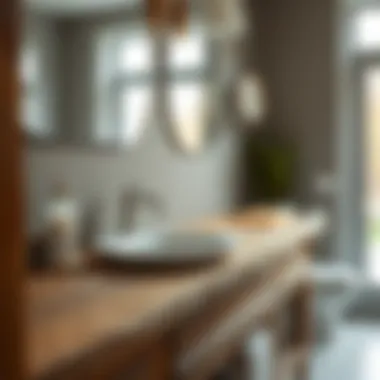
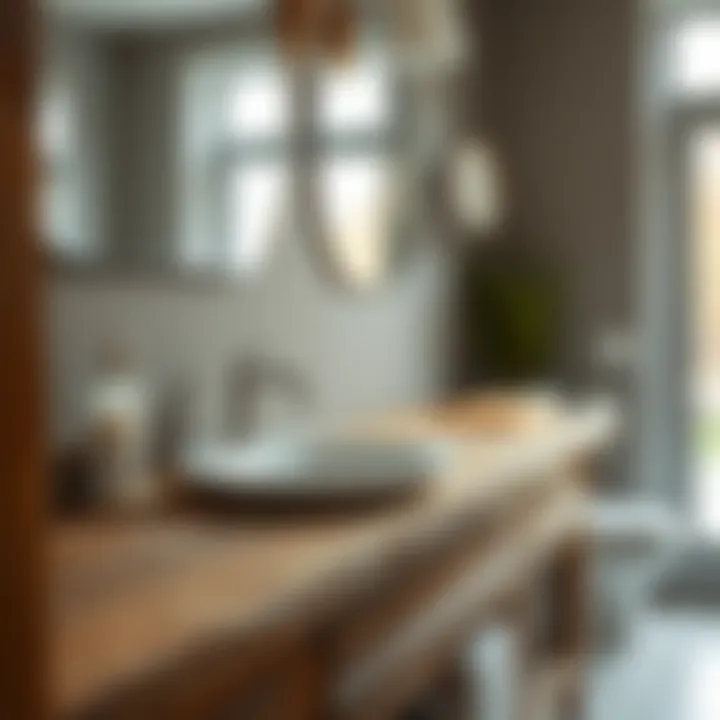
In summary, the functional aspects of bathroom countertops encapsulate ways to balance beauty with practicality. Choosing the right materials and treatments can save you headaches down the road, making your bathroom not just a place of cleanliness but a sanctuary of style and function.
Current Trends in Bathroom Countertops
In the realm of bathroom design, the countertop is not merely a surface but a canvas that reflects style, functionality, and sustainability. Understanding current trends serves as a crucial guide for homeowners, designers, and DIY enthusiasts as they navigate their options. With shifts in consumer preferences and the environmental landscape, today's trends have woven together aesthetics, practicality, and eco-consciousness.
Sustainable Choices
Sustainability isn’t just a buzzword; it's become a necessity in modern bathroom renovations. Consumers are increasingly leaning towards materials that not only look good but also adversely affect the environment less.
- Recycled Materials: Countertops made from recycled glass or composite materials are gaining traction. These options are made from materials that would have otherwise ended up in a landfill, transforming scraps into beautiful surfaces. Brands like IceStone and Cosentino offer aesthetically pleasing recycled surfaces that can fit seamlessly into various themes.
- Natural Stone: Using stones like granite or marble, sustainably sourced, is becoming a favorite for many. Those who opt for these classics appreciate their durability and timeless appeal while contributing to environmentally-friendly practices by choosing local suppliers.
- Bamboo Surfaces: For the eco-conscious, bamboo offers a sustainable countertop choice that is both beautiful and durable. Known for its rapid growth, bamboo is a rapidly renewable resource, making it a resource-friendly option.
Ultimately, opting for sustainable choices can contribute to a cleaner planet, and add unique character to one’s bathroom. Each slab tells a story, embedding a piece of history into the décor.
Innovative Designs
Functionality and creativity are not mutually exclusive, as current trends in innovative designs show us. The bathroom countertop is evolving into a versatile element of interior design, with innovations that challenge traditional perceptions.
- Integrated Sinks: The trend of seamless integration of sinks into countertops has taken center stage. This design minimizes crevices, making cleaning a breeze and adding a sleek, modern look. Materials like solid surface and quartz are ideal for this, as they can be molded to create a unified appearance.
- Textured Finishes: Gone are the days of flat, polished surfaces. Homeowners are opting for textured finishes that add depth and visual intrigue. Whether it's a honed finish or a leathered texture, these surfaces offer not only an appealing aesthetic but also practical benefits, such as enhanced grip and reduced visibility of fingerprints.
- Bold Colors and Patterns: White may be timeless, but bold hues and daring patterns are making waves. Countertops in deep blues, greens, or even vibrant reds can serve as focal points within a bathroom. Printed surfaces created with digital technology can mimic everything from marble to exotic stones, allowing for personalization that’s previously unimaginable.
The huge potential displayed by innovative design trends encourages homeowners and designers to push creative boundaries, resulting in spaces that ignite the imagination. With each countertop choice, a personality emerges, creating a harmonious and inviting environment.
"The most effective design meets both needs and desires, stitching together beauty and function."
As current trends in bathroom countertops shift towards sustainability and innovation, it's clear that these choices make profound statements about personal style and responsibility towards the environment.
Practical Tips for Choosing a Bathroom Countertop
When it comes to sourcing the right bathroom countertop, the journey is often a labyrinth of choices and considerations. Homeowners and designers alike face a barrage of options, from materials to colors, textures, and styles. Understanding how to navigate through these options can ultimately lead to a bathroom that is both functional and a feast for the eyes. Having a clear understanding of your needs and setting a realistic budget is paramount in this journey.
Assessing Your Bathroom’s Needs
Delving into what your bathroom truly requires is the first step in this process. It's not merely about aesthetics; functionality plays a vital role too. Think about how you use your bathroom daily. Is it a bustling hub with a lot of traffic, or a serene retreat primarily used for relaxation? This assessment will guide you to select a countertop that fits your lifestyle. Here are a few things to consider:
- Size and Configuration: Make sure to measure your bathroom space accurately. Consider elements like plumbing and cabinetry that could affect the installation of a larger or differently shaped countertop.
- Usage Level: If you have kids or frequently host guests, picking a surface that can endure wear and tear without showing its age quickly is necessary. Natural stones may provide the durability you need.
- Maintenance Capability: Reflect on the upkeep you can realistically commit to. Some materials require regular sealing or special cleaners, while others offer a low-maintenance solution.
- Aesthetic Compatibility: Ensure that the selected countertop harmonizes with the overall design of your bathroom. Are you going for a sleek, modern look or a more traditional vibe?
Taking these considerations into account can steer you toward a choice that serves both the practical necessities and the visual impact you desire.
Setting a Budget
Setting a budget might sound simple, but it’s actually a nuanced task that lays the groundwork for your countertop selection. Often, people overlook this step, leading to overspending or a frustrating search when their preferences outstrip their budget. Here’s how to approach your financial planning:
- Determine Your Total Spend: Start by figuring out what you truly can afford for the countertop alone. This figure should be a part of your overall bathroom renovation budget.
- Account for Installation Costs: Don’t forget to budget for installation—whether you’re leaning towards hiring a professional or planning to do it yourself. Each route has potential costs to consider.
- Consider Long-Term Value: Sometimes spending a bit more upfront can save you big time down the line, especially with countertops that don’t require frequent replacements or repairs.
- Look for Sales and Promotions: Timing can play a key role here. Keep your eyes peeled for sales or promotions from retailers, which may help you land a more expensive material within your budget.
Setting a budget is not just a number; it's also about understanding value and making informed decisions that reflect both your needs and your style.
With these practical tips, you're no longer just randomly picking material but making a considered decision aimed at creating a beautiful yet functional space. By assessing your needs and setting a sensible budget, you’re ensuring that the investment you make not only elevates your bathroom's aesthetic but also stands the test of time in functionality.
Comparative Analysis of Popular Brands
When it comes to choosing the right bathroom countertop, we’re often overwhelmed by the options available on the market today. Each brand offers its own unique flair, materials, and technologies. Therefore, a comparative analysis of popular brands becomes crucial for homeowners and designers alike. This section peels back the layers, exploring three significant brands that have made their mark in the countertop industry.
Understanding various brands allows potential buyers to weigh factors such as durability, aesthetics, and value for money. Crafting a well-informed decision helps not just in ensuring satisfaction but also in maximizing the investment.
Brand A Overview
Brand A has carved out a niche for itself in the realm of high-quality quartz countertops. Their product line boasts an impressive array of colors and patterns, offering plenty of choices for anyone aiming for a unique look. One of the standout features is their durability; these countertops are resistant to scratches and stains, making them suitable for families with children or those who frequently entertain.
Customers rave about the consistent quality of Brand A’s surfaces. However, it’s worth noting that the price point can be on the higher side. In a faux pas of sorts, some consumers have reported slight inconsistencies in color between samples and final products, which is something to be cautious about.
Pros:
- Wide variety of colors and patterns
- Durable and scratch-resistant
- Minimal maintenance required
Cons:
- Higher price range
- Potential color inconsistencies
Brand B Overview
Brand B is well-known for its sustainable practices. With growing interest in eco-friendly materials, they have launched a line of recycled glass countertops that not only look great but also contribute to reducing waste. Aesthetically pleasing with a mosaic effect, these countertops can add a contemporary vibe to any bathroom.
In terms of durability, while they are resilient, they may require a bit more maintenance compared to quartz. Buyers should know that the surfaces can be more prone to chips if not handled with care. Still, those who prioritize sustainability often find that Brand B counters are worth the investment due to their positive impact on the environment.
Pros:
- Eco-friendly options available
- Unique designs that stand out
Cons:
- Higher maintenance needs
- More susceptible to chipping
Brand Overview
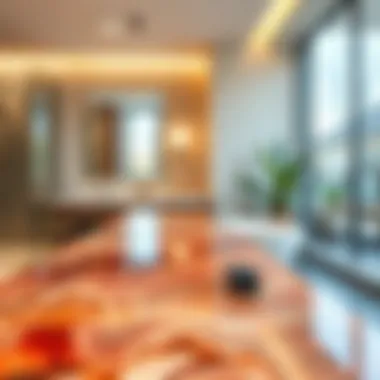
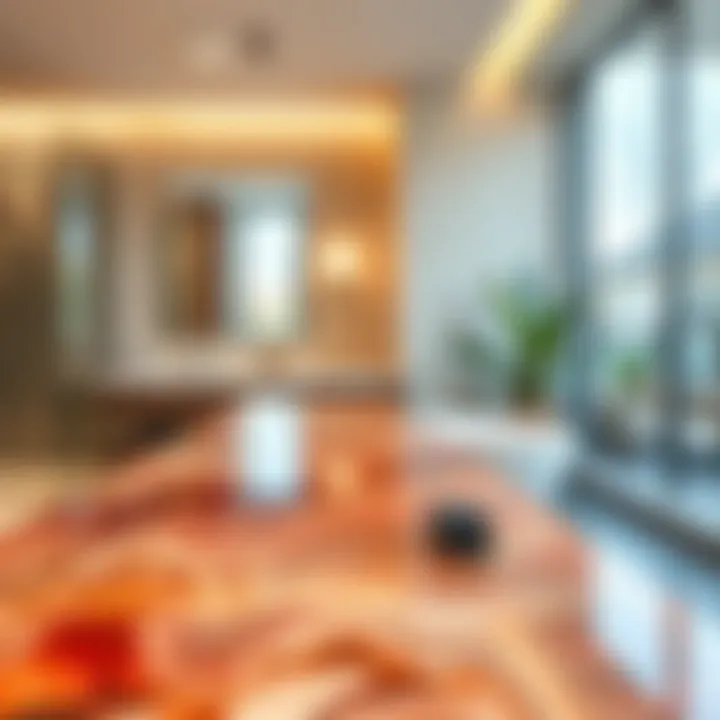
Brand C has established itself as a go-to for those favoring traditional aesthetics. Providing a rich assortment of natural stones, including granite and marble, their countertops exude elegance and class. The natural variation in the stone adds a personality that man-made materials often lack.
However, potential buyers should be aware that natural stones do require regular sealing and maintenance to protect against staining or etching. Additionally, their weight necessitates proper support during installation, which can lead to higher overall costs. But for many, the timeless look of a natural stone countertop justifies both the expense and care needed to maintain it.
Pros:
- Authentic natural beauty
- Classic and timeless appeal
Cons:
- Requires regular maintenance
- Can be heavier and more expensive to install
In closing, selecting the right brand of bathroom countertop relies heavily on personal priorities such as environmental concerns, aesthetic preferences, and budget. Each brand showcases unique benefits and trade-offs that cater to various consumer needs. By carefully examining these aspects, you can navigate the countertop landscape with a clearer perspective, ensuring your choices align with your vision.
Installation Considerations
When it comes to selecting a 72 bathroom countertop, understanding installation considerations is paramount. The countertop is a centerpiece in the bathroom, playing a pivotal role in both functionality and aesthetics. Installation choices can significantly impact not just the beauty of the space, but also its practicality and durability.
A well-thought-out installation process can save homeowners a lot of headaches down the road, ensuring the countertop stands the test of time while avoiding costly repairs. It's important to remember that each countertop material has its own installation nuances. For example, what works for a granite slab might not be suitable for a wood surface. Understanding the differences in installation processes can lead to better decisions and happier results.
The choice between hiring a professional or taking the DIY route can make all the difference. Assessing your own skill level coupled with the complexity of the chosen material can guide this decision.
Professional vs. DIY Installation
Weighing the option of professional installation against a DIY approach is crucial for anyone looking to install a 72 bathroom countertop. Engaging professionals comes with certain assurances. Skilled installers know how to handle the materials properly, minimizing the likelihood of damages and ensuring a perfect fit. Furthermore, professionals usually have the necessary equipment and expertise to install the countertop efficiently, potentially saving valuable time.
On the flip side, many DIY enthusiasts might feel driven to take this task into their own hands. The satisfaction of completing such a significant project can be rewarding. However, it's vital to consider whether the effort and risk are worth it. For instance, a rookie mistake in cutting or measuring can lead to costly errors and wasted materials. In deciding which route to take, consider the following:
- Skill Level: Are you comfortable with power tools and precision cutting?
- Material Complexity: Some materials, like quartz, require specialized handling.
- Time and Commitment: Do you have the time it takes to properly plan and execute the installation?
Tools and Equipment Needed
If choosing the DIY route, it's important to gather all necessary tools and equipment prior to starting the project. Without the right tools, even the best intentions can go awry. Here’s a concise list of what you might need:
- Measuring Tape: Precision matters; take accurate measurements of the space.
- Level: ensures that the countertop sits evenly, preventing water from pooling.
- Saws: Depending on the material, you might need a circular saw or a wet saw for stone surfaces.
- Drill: Essential for securing the countertop and creating any necessary holes for fixtures.
- Adhesive or Sealant: Depending on the surface. This is important for stone and solid surface materials.
Depending on the job's complexity, other tools such as clamps or specialized tile saws can also be beneficial. Prioritize preparation before diving in; it makes all the difference in achieving a polished finish.
Feeling overwhelmed? Don’t sweat it—plenty of online resources and forums can provide support and advice. Websites like reddit.com have dedicated DIY communities that can share tips and tricks from real-life experiences!
Common Issues and Solutions
When it comes to 72 bathroom countertops, understanding the common issues that could arise is crucial for both selecting the right material and maintaining its integrity over time. Anyone thinking of renovating or installing a new countertop needs to be aware of potential pitfalls. This section dives into some typical problems—like cracks, chips, stains, and discoloration—and discusses practical solutions to keep countertops looking their best.
Cracks and Chips
Cracks and chips on a bathroom countertop can be a real headache. These imperfections not only detract from the visual appeal of your space but can also be indicators of underlying issues, such as improper installation or a poor-quality material choice. When a countertop starts showing signs of wear and tear, it’s time to step back and assess the situation.
Cracks, for instance, can develop due to that impending exposure to heat or sudden impact. If your countertop is made of fragile materials like laminate or certain types of natural stone, consider these points:
- Avoid hot items: Always use coasters or trivets. It’s a small but effective way to prevent heat damage.
- Use cutting boards: Who needs to risk chips from knives and other sharp tools?
If a crack appears, don’t panic just yet! Minor cracks can sometimes be repaired with an epoxy resin. Applying a filler can restore the surface, but if the cracks are extensive, replacement may be the only option.
"A small crack today can turn into a bigger problem tomorrow. Proactive care is your best defense."
Stains and Discoloration
Stains are the unwelcome guests at the countertop party. They can turn that beautiful surface into an eyesore faster than you can say 'cleaning solution.' Many materials, especially porous ones like granite or marble, are susceptible to staining from the likes of makeup, toothpaste, or cleaning products.
To avoid stains, here are some preventive measures:
- Sealing: Make it part of a maintenance routine. For natural stone, sealing can create a barrier against spills.
- Quick clean-ups: Swiftly clean spills before they settle into the surface. A damp cloth is often all it takes!
If stains have already found a home, the remedy may vary based on the material. For example:
- For granite and marble, a mixture of baking soda and water can serve as a gentle scrub.
- If you’re dealing with laminate, a mild abrasive cleaner should do the trick without damaging the surface.
Ultimately, understanding how to address these common issues can prolong the lifespan of your bathroom countertop. A little diligence today makes for a solid countertop tomorrow.
The End: The Impact of Bathroom Countertops
When it comes to designing a bathroom, the influence of countertops cannot be overstated. These surfaces are often the focal point, marrying style and functionality in a space that serves daily needs. Choosing the right countertop can vastly alter the overall aesthetic and usability of a bathroom, making this topic crucial for anyone looking to enhance their restroom experience.
First and foremost, the material of the countertop plays a pivotal role in defining the bathroom's character. Whether it’s the luxurious air that marble exudes or the durable practicality of quartz, your choice can set the tone. Moreover, different materials offer varying degrees of maintenance and durability. Homeowners who are savvy about their countertop selection might find themselves weighing personal style against everyday practicality. After all, no one wants to deal with constant upkeep when a simple choice could lead to a lasting solution.
Design flexibility is another advantage. The multitude of colors, patterns, and textures allows for significant creative expression. For the modern homeowner, it means that a marble slab can coexist with an industrial-style sink or that a vibrant colored solid surface can profoundly impact a minimalist design. The versatility in design facilitates not just individual expression but also the addition of value, appealing to future buyers should one choose to renovate or resell.
Next, let’s not overlook the importance of functionality. A well-constructed countertop should not only complement the room but also serve practical purposes. Ensuring that it’s at the right height, has adequate space for toiletries, and has surfaces that can withstand stains is vital for everyday use. Missing out on these considerations can lead to frustration in what should be a relaxing atmosphere.
To sum it up, bathroom countertops hold an influential space in home design. Their array of materials invites creativity, while their role in functionality cannot be ignored. By recognizing the multifaceted impact countertops have on both aesthetic and practical elements of a bathroom, homeowners and enthusiasts can better navigate the options available. Investing time into understanding their significance ultimately leads to choices that foster satisfaction and comfort in daily routines.
"In the world of home design, it’s not just about the big picture; sometimes it’s the finest details, like a countertop, that change everything."
Final Considerations
As you draw the curtains on your bathroom renovation or upgrade project, it’s essential to step back and consider these final points:
- Personalization: Select materials and finishes that resonate with your unique taste. The bathroom often reflects personal style, so don’t shy away from bold choices.
- Quality Over Quantity: It’s better to choose one premium countertop than to clutter the space with options that lack durability or style.
- Stay Informed: Trends in countertop materials and designs constantly evolve, so being knowledgeable can aid in making informed decisions that may save money and time down the line.
In short, investing in appropriate bathroom countertops is more than a simple choice; it's a strategic decision that influences both day-to-day life and aesthetic harmony in the home.

